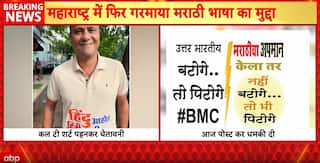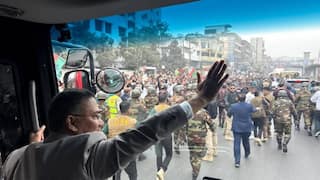1985 Air India Bombing: Terror Attack That Killed 329 People — Complete Timeline
1985 Air India Bombing: Authorities in Canada and India concluded that the bombing was planned by a Sikh extremist outfit named Babbar Khalsa.

The bombing of Air India Flight 182 Kanishka in 1985, which killed 329 people onboard, is considered one of the deadliest terrorist attacks in aviation history. The Air India flight operating on the Montreal–London–Delhi–Mumbai route disintegrated mid-air en route from Montreal to London, over the Atlantic Ocean, as a result of the explosion from a bomb planted by Sikh extremist outfit militants.
Air India Flight 182 bombing case has returned to the spotlight after Ripudaman Singh Malik, a Canadian Sikh businessman acquitted in connection to the 1985 Air India bombing, was shot dead in Surrey, British Columbia province, on Thursday, according to the news agency ANI report. The Royal Canadian Mounted Police informed the media that the killing appeared to be a "targeted shooting".
As per news agency AFP, Constable Sarbjit Sangha said that the shooters drove a vehicle, which was located in the aftermath. It was found "fully engulfed in fire", a few kilometres away from the place where Malik was shot.
Who Was Ripudaman Singh Malik?
Ripudaman Malik was allegedly associated with Babbar Khalsa. He was also a close associate of Talwinder Singh Parmar, the alleged mastermind of the Air India bombing. Malik spent four years in prison before his acquittal.
What Was The 1985 Air India Bombing Case?
On June 23, 1985, Air India Flight 182 named after the Kushan dynasty emperor ‘Kanishka’ which took off from Canada crashed off the coast of Ireland after it was bombed. The Air India Flight 182 bombing killed 329 passengers and its crew, according to news agency ANI. The victims killed in the incident included 29 entire families and 86 children under the age of 12.
The plane, which took off from Toronto, had various stops including Montreal, London, Delhi, and Mumbai. In its second leg of the journey from London, the last time after it made contact, the flight vanished from the radar screen, as per a report by India Today.
A suitcase bomb was loaded onto a plane at Vancouver's airport and then transferred in Toronto to Air India Flight 182, added the report.
1985 Air India Bombing Case Investigation
The investigation and prosecution of the Air India Flight 182 bombing case, considered the worst mass murder in Canadian history, lasted nearly 20 years. The main suspects in the bombing were members of a Khalistani group called the Babbar Khalsa, the India Today report noted. The Canadian Police arrested Talwinder Singh Parmar and Inderjit Singh Reyat in connection with Air India Flight 182 bombings, as per news agency PTI.
The national Air India inquiry concluded that Talwinder Singh Parmar was the mastermind behind the deadly mid-air bombing. Parmar, 48, was shot and killed by police in India in 1992. While another suspect, Hardial Singh Johal, died in November 2002.
Only one person named Inderjit Singh Reyat was convicted in connection to the bombings. He served 30 years for lying during two trials, including Malik's, and for helping to make the bombs at his home in Duncan, BC.
The Canadian public inquiry released a report on June 17, 2010, and a statement made by former Supreme Court Justice John Major noted that the fallout was the failure of the Canada Police and security forces, said the India Today report.
While the authorities in Canada and India concluded that the bombing was planned by a Sikh extremist outfit named Babbar Khalsa, the Canadian Commission of Inquiry also suspected the role of the International Sikh Youth Federation behind the attacks.
1985 Air India Bombing Case: Chronology Of Major Events
June 23, 1985: Air India Flight 182 leaves Toronto and explodes near Ireland, killing 329 people, 278 of them Canadians. Less than one hour before the blast, two baggage handlers at Tokyo's Narita airport are killed when a bag exploded as it was being transferred to an Air India flight.
November 8, 1985: Talwinder Singh Parmar and Inderjit Singh Reyat were arrested by the Canadian police in connection with bombings. Those charges are dropped against Parmar initially. Reyat is fined for a minor, unrelated charge.
January 22, 1986: Canadian Aviation Safety Board concludes a bomb brought down the jet.
February 1988: Reyat is arrested by police in Coventry, England, where he moved with his wife and children in 1986.
December 8, 1989: British authorities sign an extradition order for Reyat following a lengthy court battle.
May 10, 1991: Reyat, an electrician from the Vancouver Island community of Duncan, BC, is sentenced to 10 years in prison on manslaughter and explosives charges related to the Narita bombing.
May 1995: Canadian police offer a USD 1-million reward for help catching the Kanishka bombers.
March 7, 1998: National Parole Board panel denies Reyat early release.
October 27, 2000: Ajaib Singh Bagri and Ripudaman Singh Malik are arrested and charged with first-degree murder, attempted murder, and conspiracy.
June 4, 2001: British government grants permission for Reyat to be charged in the Air India blast.
June 6, 2001: Reyat is charged in Air India Flight 182 bombing just days before his 10-year sentence for his role in the Narita bombing is up. He remains in custody.
February 10, 2003: Reyat pleads guilty to one count of manslaughter and is sentenced to five years.
April 28, 2003: Bagri and Malik are set to go on trial before a judge alone in BC Supreme Court.
November 2003: Star witness against Malik testifies that the accused confessed his involvement in the bombing on at least two occasions.
March 16, 2005: British Columbia Supreme Court Justice Ian Josephson acquits Malik and Bagri, saying he found the main witnesses in the case not credible.
January 6, 2006: Reyat was charged with perjury, prosecutors allege he lied 27 times during testimony at the trials of Malik and Bagri.
May 1, 2006: Prime Minister Stephen Harper calls for a public inquiry into the Air India bombing, overruling the previous government's decision.
September 25, 2006: Former Supreme Court Justice John Major begins hearing evidence in a public inquiry.
February 15, 2008: Major concludes hearings in Air India public inquiry.
July 9, 2008: British Columbia Court of Appeals grants bail to Reyat, clearing the way for his release from prison.
December 16, 2009: Lawyer says the report from public inquiry slated for release in early 2010.
March 4, 2010: Jury selection completed for Reyat perjury trial.
June 17, 2010: Kanishka bombing Commission releases report.
(With PTI inputs)




























